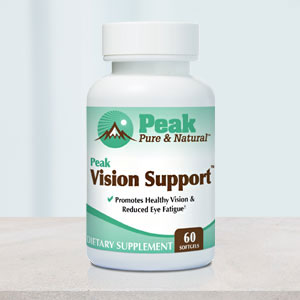Get Easy Health Digest™ in your inbox and don’t miss a thing when you subscribe today. Plus, get the free bonus report, Mother Nature’s Tips, Tricks and Remedies for Cholesterol, Blood Pressure & Blood Sugar as my way of saying welcome to the community!
Why this super drink gives you super eyesight

Of all the superfoods you’ve heard about recently, the ones that can super-charge your health and help prevent all sorts of diseases, one stands out from the crowd.
You’ve probably read about the powers of green tea to ward off cancer, protect the prostate and control blood sugar, along with many other health benefits.
Now, you can add exceptional eye health protection to that list.
Studies across the globe have proven the power of the antioxidants in green tea to prevent the progression of two eye conditions that rob thousands of people of their vision each year…
Cataracts: The leading cause of blindness
According to the World Health Organization, cataracts are responsible for more than half of blindness worldwide.
Cataracts are a clouding of the lens of the eye. Mostly, they occur with age, although they can result from eye injury or other eye diseases.
The main symptom of cataracts is blurry vision, as if you are looking through a cloudy or fogged-up window. A person with cataracts may also have trouble with night vision or experience double vision in the affected eye.
Surgical treatment can prevent blindness and improve vision if done before cataracts are too advanced.
Glaucoma: The sneaky thief of vision
After cataracts, glaucoma is the second leading cause of blindness worldwide. In the United States alone, about 12 percent of all blindness is caused by glaucoma.
You are at greater risk of developing glaucoma if you are over 60, have a family history of the condition, or are nearsighted.
The most common type of glaucoma often has no early symptoms at all, other than gradual loss of vision. A rare type of glaucoma brings eye pain, nausea and sudden vision loss.
Green tea fights these vision-stealers
Studies have shown that green tea provides potent ingredients that strengthen the eyes and help prevent cataracts and glaucoma.
The secret ingredient? A protective compound called epigallocatechin gallate, or ECGC. Catechins are an essential component of this compound.
A 2001 study in the journal Experimental Eye Research found that the catechins in green tea can prevent cataract-induced blindness.
In 2002, a study from the All India Institute of Medical Sciences discovered that green tea leaf extract protected the eyes of rats from forming cataracts.
In a 2007 study, green tea antioxidants were added to human retinal pigment epithelial cells, causing the cell count and activity to increase (epithelial cells cover and protect the cornea and protect against UV damage).
Finally, two studies in 2010 clearly demonstrated the power of green tea’s antioxidants to relieve the oxidative stress that leads to glaucoma.
In one study, researchers found that the protective effect of catechins remained at work for up to 20 hours after subjects drank green tea.
How to get your daily dose of green tea
To gain the benefits of green tea experienced in many tea-drinking cultures, the University of Maryland Medical Center suggests drinking two to three cups of green tea per day, giving you between 240 and 320 milligrams of polyphenols.
However, the bioavailability of the catechins from green tea is low. But you can help your body improve that…
According to a study published in 2022 showing green tea’s benefits for glaucoma, to improve bioavailability when drinking green tea, you can squeeze lemon juice into the tea or add a slice of lemon to enrich the tea with vitamin C.
Studies suggest that vitamin C, when used in combination with EGCG, may improve its absorption and increase its efficacy.
Matcha green tea will give you over a thousand times the antioxidant benefits of other green teas.
Matcha is stone-ground green tea made from the entire tea leaf. Usually, when you boil green tea, you throw away the leaves. Unfortunately, you’re also throwing away a lot of the antioxidants, vitamins and minerals.
Editor’s note: Have you heard of EDTA chelation therapy? It was developed originally to remove lead and other contaminants, including heavy metals, from the body. Its uses now run the gamut from varicose veins to circulation. Click here to discover Chelation: Natural Miracle for Protecting Your Heart and Enhancing Your Health!
Sources:
- Green Tea: The Eyes Have It — WebMD
- Does Green Tea Boost Your Eyesight? — LasikEyesBoston.com
- Green Tea and Eye Health — Your Sight Matters
- Can a Cup of Hot Tea a Day Help Preserve Eyesight? — The New York Times
- Frequency of a diagnosis of glaucoma in individuals who consume coffee, tea and/or soft drinks — British Journal of Ophthalmology
- Go Green: 6 Surprising Health Benefits Of Green Tea — Medical Daily
- Benefits Of Green Tea For Eye Disorders — SteadyHealth.com
- Green Tea Protects Seniors’ Eyesight, Studies Show — Live in the Now
- Why you should drink matcha green tea — Easy Health Options
- What Is Glaucoma? — WebMD
- Glaucoma Facts and Stats — Glaucoma Research Foundation
- How Much Green Tea Should You Drink Per Day? — LiveStrong.com














